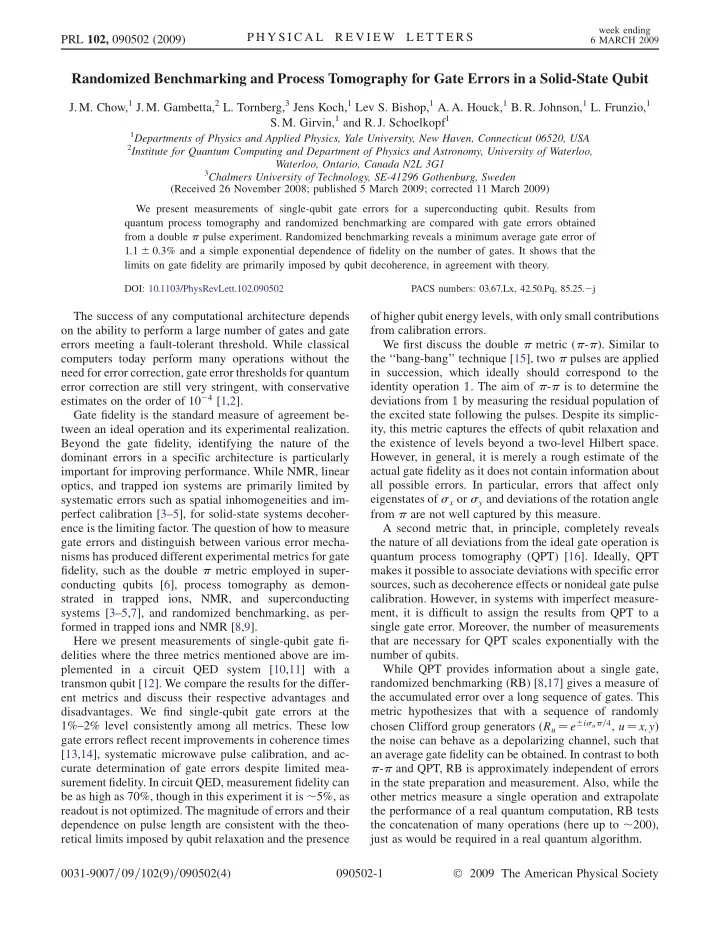

week ending P H Y S I C A L R E V I E W L E T T E R S PRL 102, 090502 (2009) 6 MARCH 2009 Randomized Benchmarking and Process Tomography for Gate Errors in a Solid-State Qubit J. M. Chow, 1 J. M. Gambetta, 2 L. Tornberg, 3 Jens Koch, 1 Lev S. Bishop, 1 A. A. Houck, 1 B. R. Johnson, 1 L. Frunzio, 1 S. M. Girvin, 1 and R. J. Schoelkopf 1 1 Departments of Physics and Applied Physics, Yale University, New Haven, Connecticut 06520, USA 2 Institute for Quantum Computing and Department of Physics and Astronomy, University of Waterloo, Waterloo, Ontario, Canada N2L 3G1 3 Chalmers University of Technology, SE-41296 Gothenburg, Sweden (Received 26 November 2008; published 5 March 2009; corrected 11 March 2009) We present measurements of single-qubit gate errors for a superconducting qubit. Results from quantum process tomography and randomized benchmarking are compared with gate errors obtained from a double � pulse experiment. Randomized benchmarking reveals a minimum average gate error of 1 : 1 � 0 : 3% and a simple exponential dependence of fidelity on the number of gates. It shows that the limits on gate fidelity are primarily imposed by qubit decoherence, in agreement with theory. PACS numbers: 03.67.Lx, 42.50.Pq, 85.25. � j DOI: 10.1103/PhysRevLett.102.090502 The success of any computational architecture depends of higher qubit energy levels, with only small contributions on the ability to perform a large number of gates and gate from calibration errors. errors meeting a fault-tolerant threshold. While classical We first discuss the double � metric ( � - � ). Similar to the ‘‘bang-bang’’ technique [15], two � pulses are applied computers today perform many operations without the need for error correction, gate error thresholds for quantum in succession, which ideally should correspond to the identity operation 1 . The aim of � - � is to determine the error correction are still very stringent, with conservative estimates on the order of 10 � 4 [1,2]. deviations from 1 by measuring the residual population of Gate fidelity is the standard measure of agreement be- the excited state following the pulses. Despite its simplic- tween an ideal operation and its experimental realization. ity, this metric captures the effects of qubit relaxation and Beyond the gate fidelity, identifying the nature of the the existence of levels beyond a two-level Hilbert space. dominant errors in a specific architecture is particularly However, in general, it is merely a rough estimate of the important for improving performance. While NMR, linear actual gate fidelity as it does not contain information about optics, and trapped ion systems are primarily limited by all possible errors. In particular, errors that affect only eigenstates of � x or � y and deviations of the rotation angle systematic errors such as spatial inhomogeneities and im- perfect calibration [3–5], for solid-state systems decoher- from � are not well captured by this measure. ence is the limiting factor. The question of how to measure A second metric that, in principle, completely reveals gate errors and distinguish between various error mecha- the nature of all deviations from the ideal gate operation is nisms has produced different experimental metrics for gate quantum process tomography (QPT) [16]. Ideally, QPT fidelity, such as the double � metric employed in super- makes it possible to associate deviations with specific error conducting qubits [6], process tomography as demon- sources, such as decoherence effects or nonideal gate pulse strated in trapped ions, NMR, and superconducting calibration. However, in systems with imperfect measure- systems [3–5,7], and randomized benchmarking, as per- ment, it is difficult to assign the results from QPT to a single gate error. Moreover, the number of measurements formed in trapped ions and NMR [8,9]. Here we present measurements of single-qubit gate fi- that are necessary for QPT scales exponentially with the delities where the three metrics mentioned above are im- number of qubits. plemented in a circuit QED system [10,11] with a While QPT provides information about a single gate, transmon qubit [12]. We compare the results for the differ- randomized benchmarking (RB) [8,17] gives a measure of the accumulated error over a long sequence of gates. This ent metrics and discuss their respective advantages and metric hypothesizes that with a sequence of randomly disadvantages. We find single-qubit gate errors at the chosen Clifford group generators ( R u ¼ e � i� u �= 4 , u ¼ x;y ) 1%–2% level consistently among all metrics. These low gate errors reflect recent improvements in coherence times the noise can behave as a depolarizing channel, such that [13,14], systematic microwave pulse calibration, and ac- an average gate fidelity can be obtained. In contrast to both � - � and QPT, RB is approximately independent of errors curate determination of gate errors despite limited mea- surement fidelity. In circuit QED, measurement fidelity can in the state preparation and measurement. Also, while the be as high as 70%, though in this experiment it is � 5% , as other metrics measure a single operation and extrapolate readout is not optimized. The magnitude of errors and their the performance of a real quantum computation, RB tests the concatenation of many operations (here up to � 200 ), dependence on pulse length are consistent with the theo- retical limits imposed by qubit relaxation and the presence just as would be required in a real quantum algorithm. 0031-9007 = 09 = 102(9) = 090502(4) 090502-1 � 2009 The American Physical Society
Recommend
More recommend